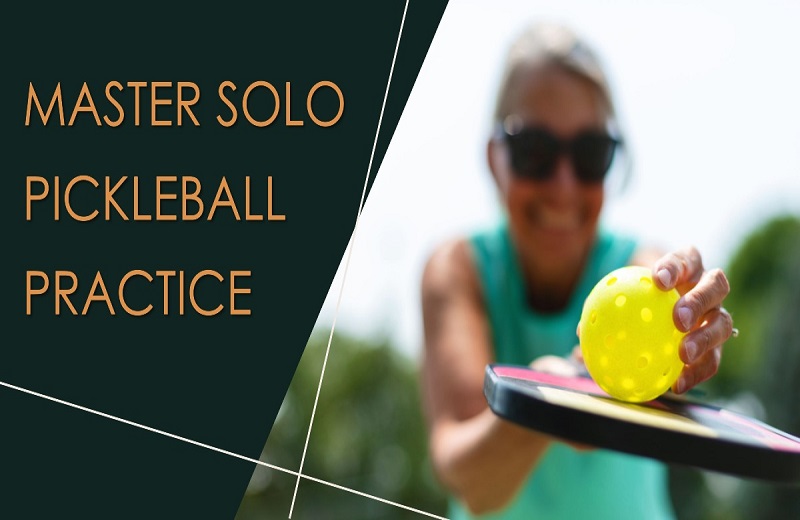How to Practice Pickleball Alone
Practice pickleball alone is not only possible, but it’s also a highly effective way to improve your skills. Solo practice allows you to focus on specific areas of your game, such as your serve accuracy, shot power, and ball control. Here are 5 ways to practice pickleball:
It gives you the freedom to set your own pace, repeat these solo drills as many times as you want, and work on your weaknesses without any pressure.
Mastering Your Shots
Mastering your shots, especially your underhand serve, is crucial in pickleball. Here’s a step-by-step guide on how to practice your shots at home:
- Find a Suitable Space: Find a wall or a pickleball rebounder where you can practice your shots. Ensure the space is safe and free from obstructions.
- Warm Up: Start with a light warm-up to prepare your body. This could include jogging on the spot, jumping jacks, or stretches.
- Start with the Basics: Begin with simple shots. Aim to hit the ball straight ahead, focusing on your form and the contact between the paddle and the ball.
- Practice Your Serve: Stand at a comfortable distance from the wall or rebounder. Practice your underhand serve, aiming to hit the ball at a particular spot on the wall. Remember, the ball should bounce once before hitting the wall.
- Increase Difficulty: As you get comfortable, increase the difficulty by aiming for smaller targets or increasing the distance.
Practice Hitting Your Forehands, Backhands, and Volleys
Your forehand, backhand, and volley are key shots in pickleball. Here’s how you can line these up at home:
- Forehand and Backhand: Stand in front of the wall or rebounder. Practice your forehand and backhand shots, alternating between them. Focus on your form, ensuring you’re rotating your body and following through with each shot.
- Volleys: Stand closer to the wall or rebounder. Hit the ball before it bounces, practicing your volley shots. Remember to keep your paddle up and in front of you, ready to respond to the ball.
Practice Pickleball Solo Drills
Practicing drills alone is an effective way to improve your skills. Here are some drills you can do:
- Accuracy Drill: Set up targets (like cones or buckets) at various distances. Practice hitting the targets with your serve, forehand, and backhand shots.
- Volley Drill: Stand close to the wall or rebounder. Practicing swing volleys without letting the ball bounce. Try to keep the rally going for as long as possible.
- Forehand and Backhand Drills: Practice your forehand drive and backhand shots, aiming for specific targets. Try to hit each target with both a forehand and a backhand shot.
- If you’re looking for new drills to try, consider exploring the Variations of Skinny Singles.
For more drill ideas, check out these comprehensive pickleball drills.
Practicing Your Legwork and Stance
Your legwork and stance are crucial in pickleball. Here’s how you can practice your footwork at home:
- Shadow Drills: Without a ball, mimic the movements you would make during a game. This includes moving side to side, forward and backward, and pivoting.
- Ladder Drills: If you have an agility ladder, use it for footwork drills. This can include in-and-out drills, lateral drills, and forward-and-backward drills.
Using a Pickleball Machine or Wall for Practice
A pickleball machine can be a great tool for practice. It can help you practice different shots and drills at your own pace. However, it’s important to consider factors such as the machine’s speed, weight, and the type of balls it uses before purchasing one. Here’s how you can use a pickleball machine for practice:
- Set Up the Machine: Place the machine at a suitable location on your court or practice area. Ensure it’s stable and secure before starting.
- Adjust the Settings: Set the machine to deliver balls at a speed and frequency that match your skill level. You can adjust these settings as you improve.
- Start with Simple Drills: Begin with simple drills, like practicing your serve or return. As you get comfortable, you can move on to more complex drills.
- Use the Machine for Target Practice: Set up targets on your court and use the machine to practice hitting them. This can help improve your accuracy and precision.
- Practice Different Shots: Use the machine to practice your forehand, backhand, and volley shots. You can adjust the machine’s settings to mimic different types of shots.
- Cool Down: After your practice session, take some time to cool down and stretch to prevent injuries.
Warm-up and Cool-down Routines for Solo Pickleball Practice
Warm-up Routine
Before you start practice pickleball alone, it’s crucial to warm up your body to prepare for physical activity and prevent injuries. Here’s a recommended warm-up routine:
- General Warm-up: Start with a general warm-up to increase your body temperature and blood flow to the muscles. This could be a brisk walk, light jog, or jumping jacks for about 5-10 minutes.
- Dynamic Stretching: After your general warm-up, move on to dynamic stretching. These are controlled movements that improve your range of motion, loosen up your muscles, and increase your heart rate. Examples include leg swings, arm circles, lunges, and high knees.
- Pickleball Specific Movements: Finally, engage in movements that mimic the actions in pickleball. This could include shadowing the forehand and backhand swings, practicing the serve motion, and lateral footwork drills. This not only warms up the specific muscles used in pickleball but also helps improve your technique.
Practice Session
After your warm-up, you can proceed to your practice session. This could include drills for improving your serve, forehand and backhand swings, volleys, and footwork. If you have the space and resources, you can also use a pickleball machine for more intensive practice.
Cool-down Routine
Once you’re done with your practice session, it’s just as important to cool down properly and duration resets. Here’s a recommended cool-down routine:
- Light Cardio: Start your cool-down with light cardio, like a slow jog or walk. This helps to gradually lower your heart rate.
- Static Stretching: After your heart rate has slowed, engage in static stretching. This involves stretching your muscles to the point of slight discomfort and holding the stretch for about 30 seconds. This helps to relax your muscles, increase their flexibility, and reduce muscle soreness. Focus on the muscles that are most used in pickleball, including your arms, shoulders, back, and legs.
- Hydrate and Rest: Finally, make sure to hydrate after your practice session. This helps to replenish any fluids lost during your practice. Also, ensure you get adequate rest to allow your muscles to recover.
Tips for Solo Practice Pickleball
Importance of Routine in Practice
Having a routine in your practice sessions can help you stay focused and make the most of your time. I like to start with some warm-up exercises, then move on to specific solo drills, and finish with some cool-down stretches.
Practicing Holding the Ball
Holding the ball correctly is crucial for executing accurate shots. I often practice holding the ball in different ways to find the grip that gives me the most control and comfort.
Importance of Muscle Memory in Pickleball
Muscle memory plays a significant role in pickleball. The more you practice a shot, the more your muscles get used to the motion, and the easier it becomes.
That’s why I always emphasize the importance of repetition in practice. Whether it’s your serve, your volley, or your dink shot, practice it over and over until it becomes second nature.
Challenges of Practicing Pickleball Alone and How to Overcome Them
Practicing pickleball alone can be a daunting task. I remember when I first started, the absence of a real opponent was a real challenge. It’s hard to simulate the unpredictability and the strategic elements of a real game. However, I found that using a wall or a pickleball machine can be an excellent substitute for a real opponent. One more way to overcome these challenges is by practicing Pickleball wall drills for solo practice.
The wall or machine returns the ball in a predictable manner, allowing me to focus on improving my strokes and footwork. The key here is self-motivation. Set goals for each practice session and strive to achieve them. Every volley, forehand, and backhand you hit brings you one step closer to becoming a better player.
Benefits of Solo Practice
The benefits of solo practice are numerous.
- First and foremost, it improves accuracy. With no opponent to return your shots, you can focus entirely on hitting the ball to specific areas of the court. This has significantly improved my volley and serve accuracy.
- Secondly, solo practice enhances muscle memory. By repeatedly performing the same movements, your body learns to execute them automatically. This is particularly beneficial for mastering the underhand serve and the forehand and backhand strokes.
- Lastly, solo practice allows you to develop your game strategy. You can experiment with different shots and movements to see what works best for you. For me, it was the kitchen play. I spent hours practicing my shots from the kitchen line, and it has become one of the strongest aspects of my game.
Can you practice pickleball on your own?
Can you play pickleball if you’re out of shape?
What is the first thing you must do when serving in pickleball?
Conclusion
In essence, how to practice pickleball is a game-changer. It’s a pathway to mastering your shots, improving accuracy, and developing game strategies. The key takeaway? Consistency is king. So, pick up your paddle, embrace the solo practice, and watch as your game transforms. Happy practicing!
Related Article:
8 Best Pickleball Drills For Two – 2 Person Effective Practice
Pickleball Dinking Drill | Improve Your Skill With Better Control


